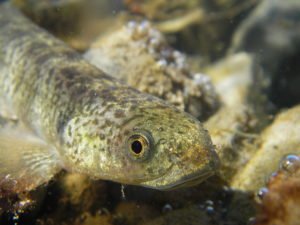The whitebait season closed around most of the country last week, with several regions reporting ‘lacklustre’ catch this year.

The whitebait fry – considered a delicacy by many – are the juveniles of five species of galaxiid, four of which are considered threatened or declining. The SMC asked freshwater experts for their views on the sustainability of the whitebait fishery and whether we’re doing enough to monitor the five species of galaxiid that make up whitebait.
Feel free to use the comments below in your reports. Additional resources are available on scimex.org.
Dr Stéphane Boyer, senior lecturer, Environmental and Animal Sciences, Unitec, comments:
“I don’t believe that whitebait fishing practices in New Zealand are sustainable. One of the big issues is that we don’t know what species we catch. Whitebait is composed of five different species of fish but, as babies, they all look very similar. Among these five species, three are declining and one is recognised as a threatened species.
“Yet we fish, sell and eat them all without distinction. It’s also been shown that poor water quality and the disappearance of their breeding habitat affects whitebait populations.
“What the industry lacks is a dedicated stock monitoring tool for whitebait. But what is certain is that we are not getting any less effective at catching whitebait. So a drop in the total catch in any season can reasonably be imputed to a drop in the population of juveniles.
“To ensure that fish stocks are renewed first we need to know what species are being fished and where they occur. This way we could protect rivers and streams where endangered or declining species occur. We need reliable data about catch to monitor population size, but this will only be useful if the data is collected for each of the five species comprising whitebait. One way to tell the species apart is by analysing their DNA.
“I am leading a research project on the DNA identification of whitebait (with funding from the Royal Society of New Zealand). This tool could eventually be used to differentiate whitebait catch containing endangered species from those only including species of least conservation concern. Eventually, it could also be used to map the distribution of the different species in rivers and to protect areas that are important for the endangered and declining species.”
Dr Mike Hickford, research associate, Marine Ecology Research Group, University of Canterbury, comments:
“The whitebait fishery has always been regionally patchy and has varied enormously from year to year. There are many people around the country that would tell you that 2016 was, in fact, their best season ever. It’s also the case that whitebaiters have notoriously short and fluid memories. Many of the people who describe this year as yet another lacklustre year conveniently forget that last year (or the year before) they had a great whitebaiting season.
“Our main problem with addressing the issue is that no one has comprehensive catch data so we have no idea what the longer-term trends are. We have no idea if fluctuations in the whitebait catch are even related to fish stocks, let alone whether the whitebait catch is in decline.
“There are no data that suggest that adult populations of the 5 species of Galaxiids that make up the whitebait fishery are recruit-limited (i.e., not enough whitebait are getting past the whitebaiters’ nets or surviving to maintain adult breeding populations). That said, there is no doubt that freshwater fish populations in New Zealand are declining, but there is no evidence to link this to whitebaiting.
“I despair at the lack of data on the whitebait fishery. In the future, I envisage a whitebaiting licence much like a Fish & Game Sports Fishing Licence. Whitebaiters would buy the licence for the number of days they wanted to fish and would have to nominate rivers and regions. The nominal fee from the licences would support research and compliance efforts, but the major benefit would be data on how many people were fishing, when and where – these are basic data required to manage a fishery.
“There are also numerous other environmental factors that impact the species throughout their life cycle. Our research has given some insight into the known stressors on spawning habitat (riparian margin modification, vegetation loss, grazing, sedimentation etc) but we know that many of the same factors impact on adult habitats and reduce adult condition and fecundity. Introduced predators (including trout) also have a huge impact on whitebait and adult populations.”
Dr Mike Joy, senior lecturer, environmental science/ecology, Massey University, comments:
“Whitebaiting is a really important thing for New Zealanders. If we don’t fight to save this right, and we do nothing about habitat loss and pollution and commercial harvesting, then we’re going to lose it.
“We have no idea whether current whitebaiting practices are sustainable because there is no requirement for records of catches to be kept. However, we do know that the number of adults is declining and their distribution is reducing. This is according to 30,000 site records in the NZ freshwater fish database.
“New Zealand probably has the highest proportion of threatened and at-risk freshwater fish species in the world. Our water and habitat quality in NZ is bad and still declining. This is driven mainly by increases in nutrients and sediment, along with physical impacts like dams, engineering (stop banking, flood control), wetland drainage etc. Then in the oceans there is eutrophication (excessive richness of nutrients) from our on-land practices, plus sea temperature increases and acidification.
“It is a complex set of factors that determine the recruitment success of whitebait in any given year. But without detailed data how these pressures interact with whitebait populations, we just can’t be sure of long-term trends.
“What is obvious is the need to reduce pressure on the juvenile galaxiids (whitebait). We should give native fish the same protection as trout and, in the short term, ban commercial harvesting in order to achieve this.”
